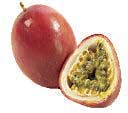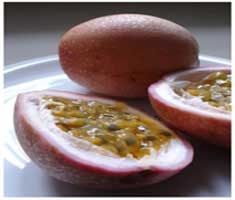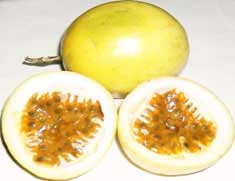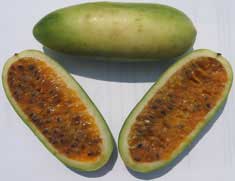 Full List of Fruits
Full List of Fruits  Passion Fruit
Passion Fruit
- Passion Fruit
- Passion Fruit Tree
- Passion Fruit Varieties
- Passion Fruit Nutrition Information
- Passion Fruit Recipe
- How to Eat Passion Fruit
Passion Fruit
Passion fruit is round to oval in shape, yellow or dark purple when mature, with a soft to hard, juicy interior filled with several seeds. The fruit can be used to eat or for its juice. The fruit shown are established for juicing and cooking use. For eating the fruit, allow the fruit to crumple for a few days to raise the sugar levels and enhance the flavor.
Appearance - Passion Fruit is like An oval melon with horns and is very decorative. Passion fruit grows on a vine ,its native is tropical and subtropical regions. Commercially, it is grown-up in Brazil, the Caribbean, Australia, Africa and some areas of the United States.
Scientific Name:Passiflora edulis
Passion Fruit is an illustration symbol of a tree, with its strong roots and trunk, it is able to support its branches, blooming with flowers and fruits of passion tree.
In winter season there are fruits on the branches. Because they grow suddenly and settle off their root systems, they are ideal for helping recover habitat. A 1-2 year old persimmon tree will be older enough to bear fruit within 7-8 years. They hold their individual against flooding riverbanks quite well and are listed in Stormwater Journal's list of water-holding trees.
Passion Fruit Varieties
Click on the below Passion Fruit you wish to find about
Yellow Passionfruit (Passiflora flavicarpa)
Banana Passionfruit (Passiflora mollissima)
The various Passion Fruits are distinguished as botanical species rather than as cultivars. The following are those most utilized for food:
Purple Passionfruit (Passiflora edulis):
Purple Passionfruit: This is the variety grown only, commercially in New Zealand at present. Variants of the purple passionfruit from Australia has been tried here and they colour up well in the heat of summer, the early and late fruit be likely to have a lot of greening, making them unacceptable in the market place.
Grown around the world, it is an egg sized fruit filled with wonderfully sharp bright orange pulp. Pulp is regularly eaten fresh, seeds are edible. Used as a flavoring in drinks, desserts, sauces, and many other foods
Yellow Passionfruit (Passiflora flavicarpa):
Vernacular Name: Golden Passionfruit, Maracuya.
Scientific Name: Passiflora edulis ,
Specimens From:Malaysia.
Specimens Weight: 90 gm.
This fruit's name, 'passion', derives from its flower, passion flower. The early Spanish explorers named it as they found the huge flowers resemble the crown of thorns, worn during the passion of Christ. This fruit usually comes in either yellow or purple, with a smooth and glossy rind.
You may wish to view the purple variety here. There are other colors too due to the hybrids between the two varieties. Passion fruit is either oval or round, about the size of a tennis ball, though some can be bigger or smaller than that. The yellow variety is usually slightly larger than its purple counterpart.
Banana Passionfruit(Passiflora mollissima)
Banana passionfruit: is the fruit of several plants in the genus and are therefore it is always related to the passion fruit. They look like a straight, small banana with rounded ends.
It has been called by its name in New Zealand, where passionfruit are also prevalent. In Hawaii, it is called banana poka. In its Latin American homeland, it is known as curuba, curuba de Castilla, or curuba sabanera blanca taxo.
Fresh Passion Fruit is high in vitamin A, Potassium and dietary fibre. The Yellow variety is used for juice, processing; the Purple variety is mostly for sold fresh in markets. Passion fruit juice is an excellent source of ascorbic acid (vitamin C).
Passion fruit have wrinkled purple brown rinds and contain several seeds. The seeds are edible,therefore the orange pulp can be eaten straight from the shell. Their pulp is aromatic and fairly sweet. In tropical countries passion fruit is primarily used for juicing.
- The juice of passion fruit reduces cancer cell growth. Though research is underway on this issue, the phytochemicals in the fruit juice are considered to inhibit cancer cell growth.
- The phenolic acids and flavonoids present in the fruit are supposed to possess heart-protecting function.
- The phenolic profile of the fruit is known for its anti-microbial activity.
- It is supposed to possess somniferous properties, which when taken before going to bed, help the person to relax and have a restful sleep. Persimmons can help prevent cancer because it is high in vitamin A.
- Passion fruit is a reservoir of Vitamin C, Vitamin A and Potassium. The seeds of the fruit are very vital sources of fiber.
 Passion Fruit Recipe
Passion Fruit Recipe
1. Passionfruit Slice
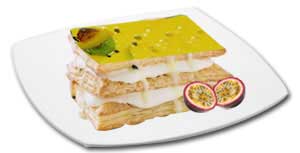
- 180 g butter, chopped
- 3/4 cup caster
- 1 teaspoon vanilla essence
- 1/2 cup plain flour
- 1 cup self-raising flour
- 1/3 cup passionfruit pulp
- 2 eggs
- 180 g butter, chopped
- 1 cup icing sugar
- 1/4 cup passionfruit pulp
Passionfruit Frosting
PREHEAT the oven to moderate 180 degrees C. Brush deep 20 cm square tin with oil. Line with grease proof paper extending over 2 sides; grease paper.
BEAT butter, sugar, eggs and vanilla essence in a small bowl with electric beaters until light and creamy. Transfer to a large bowl.
SIF flours into mixture and add passionfruit. Mix until just combined. Spoon into prepared tin and spread evenly.
BAKE for 35 minutes or until pale, golden brown. Leave in tin for 10 minutes before turning out on to rack to cool. Spread with Passion frosting.
TO MAKE Passionfruit Frosting, beat butter, icing sugar and passionfruit pulp with electric beater until light and creamy.
N0TE: Slice is best eaten on the day it is made. If using fresh passionfruit pulp, you will probably need about 8 medium-sized passionfruit.
2. Fuyu Bundt Cake
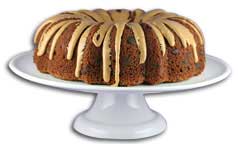
- A very simple, sophisticated use for the tropical fruit also known as 'chocolate pudding fruit'. Grease and flour a bundt cake pan. Preheat oven to 350.
- Blend 2 tsp. baking soda into 3 cups of chopped firm Fuyus. Set aside.
- In a large bowl, beat 1/2 cup soft butter with 1 2/3 cups sugar.
- Add 2 eggs, 2 tsp. lemon juice, and 2 tsp. vanilla and beat until fluffy.
- Stir in Fuyu mix.
- Sift together 2 cups flour, 1 tsp. baking powder, 1 tsp. salt, 1 tsp. ground cloves, 1 tsp. cinnamon, and 1/2 tsp. nutmeg.
- Stir flour into Fuyu mixture just until blended.
- Add 1 cup chopped walnuts and 3/4 cup raisins.
- Pour into prepared bundt pan. Bake at 350 for 55 - 60 minutes or until toothpick tests clean.
- Cool in pan 15 minutes. Turn onto rack.
Passion fruit, Passifloriacea is a special vine in native to South America (Brazil, Paraguay and Argentina). In Spanish passion fruit is called as a maracuya. There are several different species. The most commonly sold for eating is purple or yellow. The purple is the most commonly grown in the US.
Step 1:
SIMPLE - to enjoy the passion fruit with alone, cut into half and dipper out the seeds and the fruit with a spoon. The seeds are edible, munch away. The film between the seeds and the skin is edible, but not particularly tasty. If you got a very sharp passion fruit, sprinkle with sugar as you eat it.
Step 2:
JUICE - Passion fruit can be juiced, but with all the seeds and all into a mixer and crush. You can filter out the little bits or leaves depending on what you want. Common drinks with passion fruit include passion fruit-aid, passion and carrot juice, passion fruit margarita and passion fruit tea.
Step 3:
SAUCES - Use passion fruit juice just to make a sauces like a lemon juice. It is delicious in curries and over fish. Coconut milk and sauces are nicely pairs with it.
Step 4:
BAKING - Any recipe that for lemon juice can be substituted with passion fruit juice. Passion fruit poppy seed muffins, passion fruit bars and passion fruit cake.











